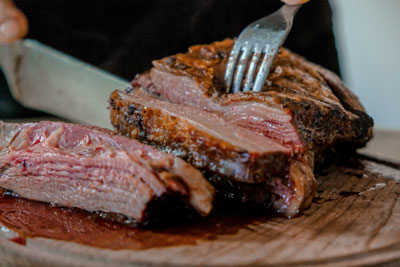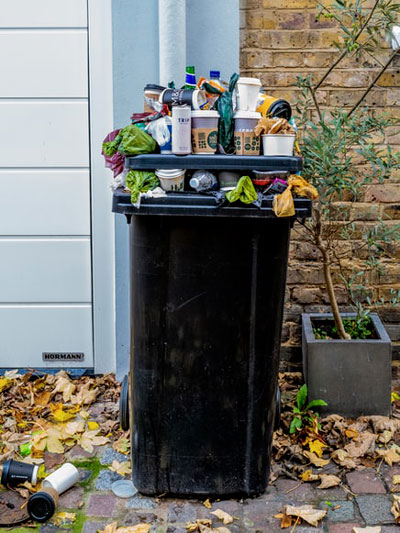When we hear about ecological damage, we think mainly about air pollution due to means of transport, or pollution of water and soil due to waste. And we often forget about the ecological consequences of what we eat. Because that’s just it – diet is directly related to all of these problems: means of transport, waste, and also the destruction of nature because of globalised crops and the use of destructive pesticides.
Diet and globalisation
The agri-food industry has turned into a monster as it has become globalised. Import-export and the sheer size of the markets involved have completely transformed the ecological impact of food production. We eat foods produced on the other side of the world and shipped to us by container ship, truck or plane, all of which emit a lot of greenhouse gases. Sometimes this involves foodstuffs that could quite easily be grown here at home, albeit sold at higher prices. Thus in hypermarkets you’ll find produce that’s out of season but cheap despite the long-distance shipping. This is because, not least, on the other side of the world the laws are less restrictive in terms of ecology, pesticides etc. And labour is far cheaper. Output can be increased, with bigger margins even if the produce has to be shipped over, and even if it means sacrificing biodiversity and sound ethics by exploiting workers on giant farms that deplete the soil and call for a lot of water or energy resources. Obviously, as soon as you start to eat more local produce, pay attention to what’s on the labels and where produce comes from, you get back in touch with its seasonal nature, taste and making mindful grocery purchases.
Greenhouse gas emissions
Besides the shipping of food products which emits greenhouse gas (CO2), livestock emit other greenhouse gases which are even more potent than CO2, like methane (CH4) and nitrous oxide (N2O). Importing feed also has to be factored in… For livestock bred for meat and also for dairy cattle. The world’s three biggest meat and milk production firms combined (JBS, Tyson and Cargill) emit more greenhouse gases than France does. Hidden from view for the consumer, there are multiple sources of greenhouse gas emissions, and the culprits are all along the chain. Because the emissions due to processing, then packaging, sale and even end-of-cycle waste management must not be overlooked. When you take a global view of all these branches, you realise how much the consumption of processed mass-produced fare, meat and imported products contributes towards increasing greenhouse gas emissions. In doing so, it contributes towards the resulting global warming. It’s time to go back to a diet that’s sourced more locally, based more on plants and fresh produce.
The appalling ecological footprint of meat

Increased meat consumption racks up detrimental consequences for the planet. The mass “production” of animals, which therefore emits huge amounts of greenhouse gases, not least in the case of beef and lamb, uses a whole lot of water. It takes more than 10,000 litres of it to produce just one kilo of beef. That places it way ahead of pork, which takes about 5,000 litres, and chicken. But more importantly, way ahead of cereal crops, which require around 700 litres for sweetcorn and up to 1,400 litres for rice, which is still much less. Thus our “water footprint” would shrink dramatically if we cut down on our meat consumption. But most importantly, some 40% of cereal crops grown worldwide are for animal feed. That’s millions of tonnes of cereal crops that could feed whole populations, but are fed to animals instead. To give you an idea of these skewed proportions, it is thought that it takes some 10 calories of plant matter to produce one calorie of beef. We would be able to feed a lot more people with those cereal crops than the meat produced through them ever will. Thus we degrade these cereal crops’ ability to feed people by turning them into a foodstuff of lower nutritional value.
Deforestation for cereal crops and livestock farms
Lastly, the high demand for land for livestock farming or cultivation of cereal crops for animal feed leads straight to deforestation. Thus livestock farmers and growers turn forests into pastures, even in the Amazon rain forest, where whole swathes of land are burned every day to make way for soya plantations for animal feed. Bearing in mind that overly-high meat intake is also bad for health, it’s yet another reason to start eating a far more plant-based diet! Thus deforestation for livestock farming purposes or for the cultivation of cereal crops for animal feed is a real scourge. It is cleverly orchestrated by producers, who want to sell ever more meat, whether as steak or processed fare. It’s the case, in particular, of soya cultivated in Brazil which is one of the world’s biggest deforestation factors. The Cerrado region has seen 50% of its savanna disappear for this reason. The same goes for vast swathes of the Amazon rainforest, whereas they trap CO2 and are home to irreplaceable treasures of biodiversity. Deforestation is responsible for around 12% of worldwide greenhouse gas emissions. Bearing in mind that crops for animal feed are causing it, the connection between our meat consumption and ecology is clear to see.
Still too much food waste

When you look at the ecological impact of food, it’s interesting to note that sometimes, all the water used, pollution generated, greenhouse gases emitted, soil depleted, packaging produced and freight transport used have all been for nothing! That’s right – in our capitalist society where you have to be able to buy everything all the time, goods are overproduced so as not to risk missing out on a sale. But accordingly, still-edible perishables get thrown away every day. This is preposterous wastefulness, bearing in mind that the planet pays the price, and that moreover, there are people starving to death. There’s a need to rethink the system and our habits: buy the right amount, re-learn how to turn leftovers into further meals, and most importantly, cut down on mass-produced food. This has a huge waste rate, throughout its life cycle from production to distribution. And in its wake, tonnes of materials are wasted on packaging. A great many apps and an anti-food waste movement have emerged. They offer solutions for buying unsold stock cheaply or cooking in a way that gets the most out of foodstuffs.
Farmland and intensive farming
Land that was once wild, and forests themselves (even if they are not primary forest like the Amazon rainforest), are rich sources of biodiversity. They also have valuable regulatory effects on the planet. And when mankind turns them into farmland, their whole ecosystem is destroyed. Roots in the ground to trap water, hedges for small animals and birds, shade to regulate humidity levels, trees to absorb CO2 and insects are all gone… Instead there are pesticides, which contribute to soil pollution, and working the soil is awfully harmful to its biological and bacteriological balance. Soil is becoming an increasingly valuable natural resource as its natural qualities disappear with crop expansion. Buying organic produce saves the soil from pesticide use. However, it does not save it from intensive soil working, which is allowed under the organic charter. To bypass this, you have to seek out organic farms that implement soil conservation practices. These are often family farms run by those passionate about and dedicated to good farming practices.
Surexploitation des océans

It’s starting to be a better-known fact that the fishing industry has a very harmful impact on marine life and on the ecosystem, because of the destructive methods used and overfishing. The EU has at long last (from 2021) prohibited electrofishing and deep-sea trawling. This involves scraping the sea bed to rake up whatever is living there. It uproots coral, and also brings up astronomical amounts what are referred to as accidental catches. The “longline” used to catch tuna consists of a line fitted with hundreds of hooks. It does not discriminate, also capturing turtles and sharks, which do not survive.
According to a 2009 WWF study, 38 million tonnes of marine animals were caught by accident in one year . That’s 40% of the world’s catch! The figures on some species beggar belief. For every kilo of prawns, between 5 and 20 kg of “collateral” gets caught too! (Fish Forward). Yet it’s impossible to inspect fishing operations everywhere, all the time. And gung-ho techniques involve the use of increasingly high-powered fishing boats packed with hardware. This leaves the marine life in their fishing waters with only a slim chance of survival. Trawlers practise large-scale fishing, which is not always very discerning. This comes down to killing hundreds and thousands of specimens for nothing, and then they just get thrown back… We are fishing the wrong way, and landing quantities far higher than what the sea can support in terms of restocking. This process leads to some fish populations being wiped out. Consequently, the balance is upset and the associated food chain disrupted.
The agri-food industry
Lastly, beyond the production of fresh produce, fruit, vegetables and dairy products, there is processed food. Once put together, precooked or frozen, the foodstuffs look very different and become “products” which are at times not easy to identify… Each preparation calls for energy use in the factory, uses up resources and generates waste. Then there’s freight transport, of course, which adds to the cost, as well as the outer packaging. Moreover, it can be said with certainty that these products, with their over-cautious ‘best before’ dates, are the items most frequently thrown away by supermarkets. Let alone that mass-produced foods call for the use of chemicals to add taste and flavour, are often full of sugar and salt and made from by-products. Basically, they are bad for the planet and bad for health. In fact, it’s almost impossible to eat a responsible diet if you stick to supermarket shopping…
Boycotting in practical terms
There are brands that are now known to use bad production methods, and also products and foods that have a disastrous ecological impact. Sadly, palm oil is known to come from crops planted thanks to deforestation, often done illicitly, which directly and fatally deprives orangutans of their habitat. Moreover, the Coca-Cola Company draws on water table water all over the world, depriving local populations of drinking water. This is particularly the case in Mexico, where carbonated drinks intake has set off an epidemic of diabetes and obesity. Lastly, avocado cultivation, which uses a lot of water, is clustered in countries where it is in short supply. This confounds water depletion with long-distance shipping for import. Another example is cashew nuts harvested by hand by poverty-struck populations, with plantation workers sustaining skin burns due to the toxic substances contained in the fruit. Having an epiphany as to the direct effects that our choices as consumers have on the planet allows us to make different, more virtuous choices and thus boycott certain products. Remember that demand is the only thing that fuels supply…
Five ways to eat a more ecologically-sound diet




- Eat less fish and meat
- Buy produce that’s locally sourced or has short supply chains (from associations for the preservation of smallholdings, via fruit and veg boxes, etc.)
- Boycott agri-food multinationals
- Buy loose groceries and seasonal produce
- Steer clear of processed and pre-cooked foods
Ecology is also about what you eat, or rather what you put in your shopping trolley or basket. There’s an urgent need to get back to mankind’s natural diet, which is more plant-based than the one we eat today! Our bodies are not designed for us to eat meat four times a week, or dairy products every day, and that does not suit the planet either. Making for a more plant-based diet, buying groceries locally and recognising the value of foodstuffs by sourcing them from producers who are aware of the issues make it possible to influence the market’s direction of travel. More importantly, it also allows you to give your money to those who need it.
Pay a fair price for foods, and thus avoid the big brands which are polluting and poison us with their cheap junk food!







